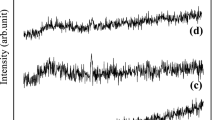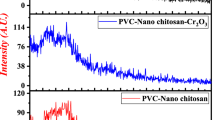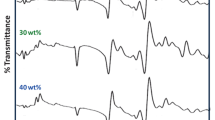Abstract
In this work, different weight percentages of nanoclay (NC) (2% and 5%) and N-vinyl carbazole were prepared by chemical polymerization. For investigation of structure, optical and morphologies of samples, Fourier transform infrared spectroscopy, ultraviolet–visible spectroscopy and scanning electron microscopy were used, respectively. Moreover, dielectric properties of composites were examined using dielectric analysis system and vector network analyzer system at high frequency. It was seen that the values of the real and imaginary dielectric constants and loss factor decrease with doping nanoclay into poly(N-vinyl carbazole) (PNVC). The conductivity properties of all samples were studied, and “s” parameter was calculated. Up to 1.7 GHz, “s” parameter value correlated with Jonscher power law, and between 1.7 GHz and 20 GHz, “s” parameter value correlated with superlinear power law. Also, the atomic polarization behaviors in the high-frequency regions have been obtained for PNVC and PNVC doped with 2%, 5% NCs at 25 °C.









Similar content being viewed by others
References
Khatoon H, Ahmad S (2017) A review on conducting polymer reinforced polyurethane composites. J Ind Eng Chem 53:1–22
Sethi D, Ram R, Khastgir D (2017) Electrical conductivity and dynamic mechanical properties of silicon rubber-based conducting composites: effect of cyclic deformation, pressure and temperature. Polym Int 66(9):1295–1305
Sethi D, Ram R, Khastgir D (2018) Analysis of electrical and dynamic mechanical response of conductive elastomeric composites subjected to cyclic deformations and temperature. Polym Compos 39(11):3912–3923
Vicentini DS, Barra GM, Bertolino JR, Pires AT (2007) Polyaniline/thermoplastic polyurethane blends: preparation and evaluation of electrical conductivity. Eur Polym J 43(10):4565–4572
Subramaniam CK, Kaiser AB, Gilberd PW, Liu CJ, Wessling B (1996) Conductivity and thermopower of blends of polyaniline with insulating polymers (PETG and PMMA). Solid State Commun 97(3):235–238
Ram R, Rahaman M, Khastgir D (2014) Mechanical, electrical, and dielectric properties of polyvinylidene fluoride/short carbon fiber composites with low-electrical percolation threshold. J Appl Polym Sci 131(3):39866
Ram R, Rahaman M, Aldalbahi A, Khastgir D (2017) Determination of percolation threshold and electrical conductivity of polyvinylidene fluoride (PVDF)/short carbon fiber (SCF) composites: effect of SCF aspect ratio. Polym Int 66(4):573–582
Snook GA, Bhatt AI, Abdelhamid ME, Best AS (2012) Role of H+ in polypyrrole and poly(3, 4-ethylenedioxythiophene) formation using FeCl3·6H2O in the room temperature ionic liquid, C4mpyrTFSI. Aust J Chem 65(11):1513–1522
Ram R, Khastgir D, Rahaman M (2018) Physical properties of polyvinylidene fluoride/multi‐walled carbon nanotube nanocomposites with special reference to electromagnetic interference shielding effectiveness. Adv Polym Technol
Ram R, Rahaman M, Khastgir D (2015) Electrical properties of polyvinylidene fluoride (PVDF)/multi-walled carbon nanotube (MWCNT) semi-transparent composites: modelling of DC conductivity. Compos A Appl Sci Manuf 69:30–39
Rahman MS, Hammed WA, Ro Y, Ekramul Mahmud HNME (2017) Optoelectrical and photoluminescence quenching properties of poly(N-vinyl carbazole)-polypyrrole/reduced graphene oxide nanocomposites. Synth Met 226:188–194
Zhong J, Gao S, Xue G, Wang B (2015) Study on enhancement mechanism of conductivity induced by graphene oxide for polypyrrole nanocomposites. Macromolecules 48:1592–1597
Yoon H (2013) Current trends in sensors based on conducting polymer nanomaterials. Nanomaterials 3:524–549
Lei W, Si W, Xu Y, Gu Z, Hao Q (2014) Conducting polymer composites with graphene for use in chemical sensors and biosensors. Microchim Acta 181:707–722
Yoo D, Kim J, Kim JH (2014) Direct synthesis of highly conductive poly(3,4-ethylenedioxythiophene): poly(4-styrenesulfonate)(PEDOT:PSS)/graphene composites and their applications in energy harvesting systems. Nano Res 7:717–730
Ravindranadh K, Rao MC (2013) Physical properties and applications of conducting polymers: an overview. Int J Adv Pahrm Biol Chem 2:190–200
Grund S, Eichberg J, Asmussen F (1982) A specific embedding resin (PVK) for fine cytological investigations in the photoemission electron microscope. J Ultrastruct Res 80:89–97
Huang CF, Hsieh YA, Hsu SC, Matyjaszewski K (2014) Synthesis of poly(N-vinyl carbazole)-based block copolymers by sequential polymerizations of RAFT-ATRP. Polymer 55:6051–6057
Grazulevicius JV, Strohriegl P, Pielichowski J, Pielichowski K (2003) Carbazole-containing polymers: synthesis, properties and applications. Prog Polym Sci 28:1297–1353
Petukhova A, Greener J, Liu K, Nykypanchuk D, Nicolay R, Matyjaszewski K, Kumacheva E (2012) Standing arrays of gold nanorods end-tethered with polymer ligands. Small 8:731–737
Block H, Bowker SM, Walker SM (1978) Photoconductivities of poly(N-vinyl carbazoles) containing cation radicals. Polymer 19:531–536
Penwell RC, Prest WM Jr (1978) Orientation in poly(n-vinyl carbazole) by melt extrusion. Polymer 19:537–541
Ahlatcioǧlu E, Şenkal BF, Okutan M (2015) Preparation and electrical characterization of poly(aniline) nano clay composites. High Temp Mater Process (London) 34:341–346
Aal NA, Al-Hazmi F, Al-Ghamdi AA, Al-Ghamdi AA, El-Tantawy F, Yakuphanoglu F (2015) A novel facile synthesis and electromagnetic wave shielding effectiveness at microwave frequency of graphene oxide paper. Microsyst Technol 21(10):2155–2163
Basavaraja C, Thinh PX, Huh DS (2013) Characterization and electrical behavior of biodegradable poly(n-vinylcarbazole)/poly(3-hydroxybutyric acid) composite films. Macromol Res 21:574–581
Mansour N, Momeni A, Karimzadeh R, Amini M (2012) Blue-green luminescent silicon nanocrystals fabricated by nanosecond pulsed laser ablation in dimethyl sulfoxide. Opt Mater Express 2:740–748
Lin SW, Chen DH (2009) Synthesis of water-soluble blue photoluminescent silicon nanocrystals with oxide surface passivation. Small 5:72–76
Boddula R, Srinivasan P (2014) Benzoyl peroxide oxidation route to the synthesis of solvent soluble polycarbazole. Int Sch Res Not 2014:1–9
Azzam EMS, Sayyah SM, Taha AS (2013) Fabrication and characterization of nanoclay composites using synthesized polymeric thiol surfactants assembled on gold nanoparticles. Egypt J Petrol 22(4):493–499
Yakuphanoglu F, Al-Ghamdi AA, El-Tantawy F (2015) Electromagnetic interference shielding properties of nanocomposites for commercial electronic devices. Microsyst Technol 21(11):2397–2405
Korkmaz B, Özerol EA, Bozdoğan AÇ, Okutan M, Şenkal BF, Gursel YH (2017) Synthesis and characterization of a new hydrogen bonded side chain liquid crystal block copolymer and investigation of electrical properties. Pure Appl Chem 89(1):19–28
Ahlatcıoğlu E, Gursel Y, Okutan M, Senkal BF (2014) Preparation of poly (N-vinylcarbazole)-co-poly (2-(dimethylamino) ethyl methacrylate) based hydrogen bonded side-chain liquid crystal copolymer. Mater Sci Semicond Process 28:144–150
Jonscher AK (1978) The universal dielectric response: a review of data their new interpretation. Chelsea Dielectrics Group, London
Ahlatcıoğlu Özerol E, Şenkal BF, Okutan M (2015) Preparation and characterization of graphite composites of polyaniline. Microelectron Eng 146:76–80
Meller A (1983) Gmelin Handbuch der Anorganische Chemie, Boron compounds, 2nd edn. Springer, Berlin
Author information
Authors and Affiliations
Corresponding author
Rights and permissions
About this article
Cite this article
Ahlatcıoğlu Özerol, E. Electro-optical properties of poly(N-vinyl carbazole) nanoclay composites. Polym. Bull. 76, 5301–5311 (2019). https://doi.org/10.1007/s00289-018-2654-x
Received:
Revised:
Accepted:
Published:
Issue Date:
DOI: https://doi.org/10.1007/s00289-018-2654-x




